i'm new in swift programming. I want when user tap a MKAnnotationPoint to move on the next view controller. The way i do it now is by pressing the Button "Button" as you see at the top of image1. My code:
mapViewController.swift
import UIKit
import MapKit
import CoreLocation
class mapViewController: UIViewController, UITextFieldDelegate, UIImagePickerControllerDelegate, UINavigationControllerDelegate, CLLocationManagerDelegate, MKMapViewDelegate {
// MARK: Properties
let pin = UIImage(named: "pin")
var annotationTouched = String()
var viaSegue = MKAnnotationView()
// MARK: MAP
@IBOutlet weak var mapView: MKMapView!
let coreLocationManager = CLLocationManager()
let locations = LocationList().Location
// all locations will be stored on this array
func locationManager(_ manager: CLLocationManager, didUpdateLocations locations: [CLLocation])
{
let location = locations [0]
//map zoomed
let span:MKCoordinateSpan = MKCoordinateSpanMake(0.003, 0.003)
//users location
let myLocation:CLLocationCoordinate2D = CLLocationCoordinate2DMake(location.coordinate.latitude, location.coordinate.longitude)
let region:MKCoordinateRegion = MKCoordinateRegionMake(myLocation, span)
mapView.setRegion(region, animated: true)
self.mapView.showsUserLocation = true
}
// func to change red pin to my custom pin
func mapView(_ mapView: MKMapView, viewFor annotation: MKAnnotation) -> MKAnnotationView?
{
if let annotation = annotation as? Locations{
if let view = mapView.dequeueReusableAnnotationView(withIdentifier: annotation.identifier){
return view
}else{
let view = MKAnnotationView(annotation: annotation, reuseIdentifier: annotation.identifier)
view.image = pin
view.isEnabled = true
view.canShowCallout = true
//view.leftCalloutAccessoryView = UIImageView(image: pin)
let btn = UIButton(type: .detailDisclosure)
view.rightCalloutAccessoryView = btn
return view
}
}
return nil
}
// assigning the pin that is selected in the map to the annotation touched variable
func mapView(_ mapView: MKMapView, didSelect view: MKAnnotationView)
{
if let annotation = view.annotation as? Locations {
annotationTouched = annotation.title ?? "No title"
}
}
override func viewDidLoad()
{
super.viewDidLoad()
coreLocationManager.delegate = self
//desired accuracy is the best accuracy, very accurate data for the location
coreLocationManager.desiredAccuracy = kCLLocationAccuracyBest
//request authorization from the user when user using my app
coreLocationManager.requestWhenInUseAuthorization()
coreLocationManager.startUpdatingLocation()
mapView.delegate = self
mapView.addAnnotations(locations)
}
// passing the name of the place on the next view controller which is the review view controller (RateViewController)
override func prepare(for segue: UIStoryboardSegue, sender: Any?)
{
let destViewController : RateViewController = segue.destination as! RateViewController
destViewController.placeLabelString = annotationTouched
}
}
Locations.swift
import UIKit
import MapKit
class Locations: NSObject, MKAnnotation {
// required coordinate, title, and the reuse identifier for this annotation
var identifier = "locations"
var title: String?
var coordinate: CLLocationCoordinate2D
//initializer taking a name, a latitude and longitude to populate the title and coordinate for each instance of this object
init(name:String,lat:CLLocationDegrees,long:CLLocationDegrees){
title = name
coordinate = CLLocationCoordinate2DMake(lat, long)
}
}
// Creating the list of the places that will be pinned in map
class LocationList: NSObject {
var Location = [Locations]()
override init(){
Location += [Locations(name: "Dio Con Dio", lat: 40.590130, long: 23.036610)]
Location += [Locations(name: "Paradosiako - Panorama", lat: 40.590102, long:23.036180)]
Location += [Locations(name: "Veranda", lat: 40.607740, long: 23.103044)]
Location += [Locations(name: "Markiz", lat: 40.634252, long: 22.936276)]
Location += [Locations(name: "Moi Lounge Bar", lat: 40.653481, long: 22.994131)]
Location += [Locations(name: "Boulevard Lounge Bar", lat: 40.658462, long: 22.983198)]
Location += [Locations(name: "Ernést Hébrard", lat: 40.631829, long: 22.941014)]
Location += [Locations(name: "Tribeca - All Day & Night Bar", lat: 40.631029, long: 22.942396)]
}
}


